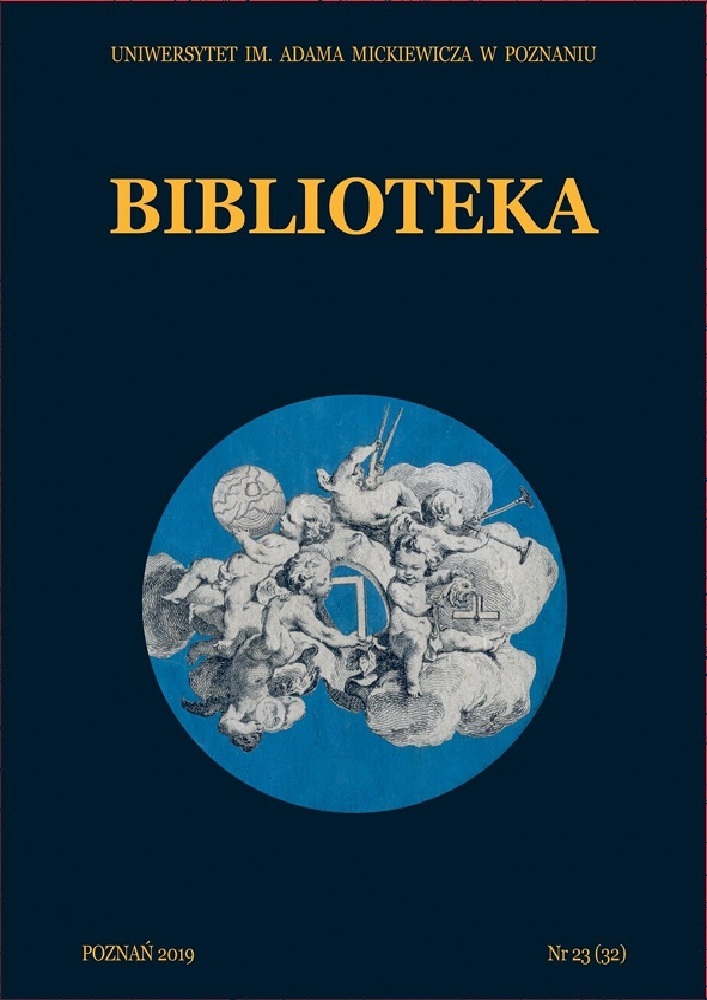Abstract
While making a comparison between librarianship and other professions one may conclude that the former has been more and more laden with new responsibilities and new priorities. Though the librarian as the “knowledge physician” was a construct that underlined the need for the prestige and social standing of the profession, rather than focused on the essence of the librarian profession, the idea of quasi medical role of the librarian and nearly doctor-like responsibility for the patient/user can have indeed something to do with today’s need for implementing the so-called “curated” processes, that is the ones that require a particularly insightful and extensive knowledge of the subject and available methods of management. And this applies to all possible areas related to the circulation of information. Within the context of two case examples of complex and complicated scientific texts and an attempt to identify how a public discussion on them can be carried out, this article attempts to identify the key points in which, without the mediation of the librarian, science can generate a string of misunderstandings, fallacies and conceptual incoherencies or become marginalised. In conclusion, the author proposes to strengthen personnel training, policy support, to create an innovative environment, and promote the development of awareness of any possible manifestations of librarian curatorship in a variety of activities that might be undertaken by librarians. Further strengthening of research and knowledge competences of librarians seems inevitable, in particular in view of the need for the development of inter-disciplinary sciences and a particular supervision needed for research conducted by multi-person research teams as well as for collectively written texts authored by a number of researchers.
References
Aptroot M., Yiddish language and Ashkenazic Jews: a perspective from culture, language, and literature, „Genome Biology and Evolution” 2016, nr 6, s. 1948–1949.
Architektki miasta? Kuratorki miasta? Prezentacja książki i dyskusja: a City curating reader, Public Art Munich, 2018, w: Biennale Warszawa, 13.02.2019, https://biennalewarszawa.pl/architektki-miasta-kuratorki-miasta/ [dostęp: 1.07.2019].
Benessia A. et al., The rightful place of science: science on the verge, Washington, DC: Consortium for Science, Policy & Outcomes 2016.
Blanton-Peale Institute & Counselling Center, https://www.blantonpeale.org/[dostęp: 1.07.2019].
Czy Żydzi pochodzą od Chazarów? Wykład prof. Shaula Stampfera, Muzeum Historii Żydów Polskich POLIN, 17.06.2015, https://www.polin.pl/pl/wydarzenie/czy-zydzi-pochodza-od-chazarow [dostęp: 1.07.2019].
Das R. et al., Localizing Ashkenazic Jews to Primeval Villages in the Ancient Iranian Lands of Ashkenaz, „Genome Biology and Evolution” 2016, nr 4, s. 1132–1149, https://academic.oup.com/gbe/article/8/4/1132/2574015 [dostęp: 1.07.2019].
Hollender H., Nauka jako mrowisko i miejsce biblioteki w sieciach współpracy badawczej, w: Biblioteka przyszłości – wyzwania – trendy – zagrożenia. Wybrane zagadnienia z zakresu zarządzania bibliotekami uczelni wyższych, red. M.W. Sidor, Nowy Sącz: Wyższa Szkoła Biznesu – National Louis University 2018, s. 133–140.
Hollender H., Those inconspicuous journals: are they scholarly publications?, „Puls Uczelni” 2015, nr 4, s. 30–33, https://depot.ceon.pl/handle/123456789/9004 [dostęp: 1.07.2019], DOI: 10.5604/2081-2021.1191751.
Home / About the journal, „International Journal of Digital Curation”, http://www.ijdc.net/about [dostęp: 1.07.2019].
Hoseini S.S., Masturbation: scientific evidence and Islam’s view, „Journal of Religion and Health” 2017, nr 6, s. 2076–2081.
Hudson-Vitale C. et al., Data Curation, Washington, DC: ARL 2017.
Jazdon A., Czy jest na sali Nostradamus? O trudnym zadaniu kreślenia wizji przyszłości bibliotek, w: Biblioteka przyszłości – wyzwania – trendy – zagrożenia. Wybrane zagadnienia z zakresu zarządzania bibliotekami uczelni wyższych, red. M.W. Sidor, Nowy Sącz: Wyższa Szkoła Biznesu – National Louis University 2018, s. 19–40.
Paroszkiewicz S., Content curation – czym jest i jak wykorzystać go w twojej komunikacji?, Interaktywnie.com, 25.02.2016, https://interaktywnie.com/okiem-eksperta/content-curation-czym-jest-i-jak-wykorzystac-go-w-twojej-komunikacji-252626 [dostęp: 1.07.2019].
Piasecki W., Zawód bibliotekarza naukowego, Gliwice: [Politechnika Śląska] 1956, s. 4.
Piasecki W., My wobec innych zawodów, „Przegląd Biblioteczny” 1962, z. 4, s. 289–300.
Sabharwal A., Digital curation in the digital humanities: preserving and promoting archival and special collections, Amsterdam: Elsevier/Chandos Publishing 2018.
Speed D., Cragun R.T., „Response to ‘Masturbation: scientific evidence and Islam’s view’”, „Journal of Religion and Health” 2018, nr 1–4, https://doi.org/10.1007/s10943-018-0627-x [dostęp: 1.07.2019].
Witkowska M., Konferencja „Czasopisma naukowe w bibliotekach – zmierzch czy świt?” – sprawozdanie, https://repozytorium.uwb.edu.pl/jspui/bitstream/11320/4616/1/Sprawozdanie%20Gdańsk.pdf, http://hdl.handle.net/11320/ [dostęp: 1.07.2019].
Ziman J., Społeczeństwo nauki, przeł. E. Krasińska, przedmowa B. Suchodolski, Warszawa: Państwowy Instytut Wydawniczy 1972.
License
Copyright (c) 2019 Henryk Hollender

This work is licensed under a Creative Commons Attribution-ShareAlike 4.0 International License.
Utwory opublikowane w czasopiśmie Biblioteka, na platformie Pressto należącej do Uniwersytetu im. Adama Mickiewicza w Poznaniu od 2015 roku są udostępniane na
licencji Creative Commons Uznanie autorstwa-Na tych samych warunkach 4.0 Międzynarodowe.
Tym samym wszyscy zainteresowani są uprawnieni do korzystania z utworów opublikowanych po 2015 roku pod następującymi warunkami:
- uznania autorstwa czyli obowiązek podania wraz z rozpowszechnianym utworem informacji o autorstwie, tytule, źródle (odnośniki do oryginalnego utworu, doi) oraz samej licencji
- na tych samych warunkach — remiksując utwór, przetwarzając go lub tworząc na jego podstawie, należy swoje dzieło rozpowszechniać na tej samej licencji, co oryginał.
Uniwersytet im. Adama Mickiewicza w Poznaniu zachowuje prawo do czasopisma jako całości (układ, forma graficzna, tytuł, projekt okładki, logo itp.).
Autor zachowuje prawa majątkowe, ale udziela zgody Uniwersytetowi im. Adama Mickiewicza w Poznaniu na wykorzystanie dzieła. Autorzy tekstów zakwalifikowanych do publikacji proszeni są o wypełnienie podpisanie i przesłanie umowy.
Jeżeli autor artykułu nie jest przekonany, że może wykorzystywać cudze utwory (np. ilustracje, fotografie, tabele) w ramach cytatu we własnej tekście musi dostarczyć do redakcji czasopisma zgodę od uprawnionych podmiotów.
Prawa są zastrzeżone do wszystkich tekstów opublikowanych przed rokiem 2015.





